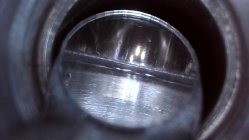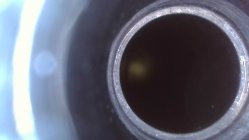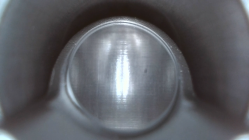Love 'em or hate 'em they are here and cheap. Regardless of your beliefs on cleaning, you don't really know what's going on in there unless you look. I was shocked at my rifles! Caked black $h!t all the way and layered beautifully with copper. Carbon rings in the chambers had to be causing problems.
Hoppes, a bronze brush 1 stroke per shot, and patch out until they come clean may have worked for "....your daddy's shotgun, Cowboy," but my rifles deserve better!
I got frustrated trying to figure out what I was looking at, how to interpret it, and how far to go getting rid of what I thought I saw. Not a lot out there. Gunsmith's dirty little financial secret when presented with a rifle that doesn't shoot is to clean it properly. By the hour I presume! The bore (snake oil) solvent companies aren't helping because basically their products all work the same. Poorly! Benchrest guys? Competition is too close to give up many secrets but they are definitely on one end of the spectrum. Some of the guntube crowd are trying, but several times what they called firecracking, I called caked carbon (Bryan Litz vid) that departed quickly with Iosso. Barrel manufacturers are all over the place.
So let's use this tech to throw up some pictures/videos and educate ourselves. What works, what doesn't and what it looks like. Maybe this thread will grab hold.
So I've been obsessed with carbon ring removal. Today, I got one down to this........(Sorry the idea for this thread struck me after I had started work so there is no true "before" photo)

Anyone who has worked one of these knows it gets to diminishing returns. So how much effort is needed? 100% every cleaning? I accidentally stumbled on a potential answer. I pulled the mirror off the borescope, which I seldom do, because I saw something on the chamber shoulder I didn't like. It was nothing but this is the leading edge of the leade.....

So am I right in thinking that as long as the carbon buildup stays below the leade ledge (I'll stop) and short of the brass neck, I'm, good? I really don't think this carbon is enough to constitute a ring. Let alone have any impact on accuracy.
Also, in my first photo. I have yet to attack that black gunk in the leade and the 6" beyond. It sure is pretty and shiny though! At this point Wipeout Patchout and bronze brushes have quit working. All patches are clean. In my opinion it isn't clean until a bit of abrasive gets that back to metal color. Admittedly, I probably go too far with abrasives but it's mine and I can wash it as fast or as slow as I want. I believe clean is clean. I have a hard time worrying that a bit of greasy dead sea critters (Iosso) on a patch can inflict any damage close to an oversized projectile launched down a pipe and spun at 150,000 rpm, under 60,000 psi in a 5,000 degree plasma cloud.
Lets talk rimfires too if you want.
We can skip "the barrel will tell you" talk also. (drives me nuts) That's the equivalent if not doing a front end alignment until it starts to wobble. The barrel will only tell you what you know how ask it and the language it responds in may be a total mystery.
Happy Friday.
Hoppes, a bronze brush 1 stroke per shot, and patch out until they come clean may have worked for "....your daddy's shotgun, Cowboy," but my rifles deserve better!
I got frustrated trying to figure out what I was looking at, how to interpret it, and how far to go getting rid of what I thought I saw. Not a lot out there. Gunsmith's dirty little financial secret when presented with a rifle that doesn't shoot is to clean it properly. By the hour I presume! The bore (snake oil) solvent companies aren't helping because basically their products all work the same. Poorly! Benchrest guys? Competition is too close to give up many secrets but they are definitely on one end of the spectrum. Some of the guntube crowd are trying, but several times what they called firecracking, I called caked carbon (Bryan Litz vid) that departed quickly with Iosso. Barrel manufacturers are all over the place.
So let's use this tech to throw up some pictures/videos and educate ourselves. What works, what doesn't and what it looks like. Maybe this thread will grab hold.
So I've been obsessed with carbon ring removal. Today, I got one down to this........(Sorry the idea for this thread struck me after I had started work so there is no true "before" photo)

Anyone who has worked one of these knows it gets to diminishing returns. So how much effort is needed? 100% every cleaning? I accidentally stumbled on a potential answer. I pulled the mirror off the borescope, which I seldom do, because I saw something on the chamber shoulder I didn't like. It was nothing but this is the leading edge of the leade.....

So am I right in thinking that as long as the carbon buildup stays below the leade ledge (I'll stop) and short of the brass neck, I'm, good? I really don't think this carbon is enough to constitute a ring. Let alone have any impact on accuracy.
Also, in my first photo. I have yet to attack that black gunk in the leade and the 6" beyond. It sure is pretty and shiny though! At this point Wipeout Patchout and bronze brushes have quit working. All patches are clean. In my opinion it isn't clean until a bit of abrasive gets that back to metal color. Admittedly, I probably go too far with abrasives but it's mine and I can wash it as fast or as slow as I want. I believe clean is clean. I have a hard time worrying that a bit of greasy dead sea critters (Iosso) on a patch can inflict any damage close to an oversized projectile launched down a pipe and spun at 150,000 rpm, under 60,000 psi in a 5,000 degree plasma cloud.
Lets talk rimfires too if you want.
We can skip "the barrel will tell you" talk also. (drives me nuts) That's the equivalent if not doing a front end alignment until it starts to wobble. The barrel will only tell you what you know how ask it and the language it responds in may be a total mystery.
Happy Friday.












